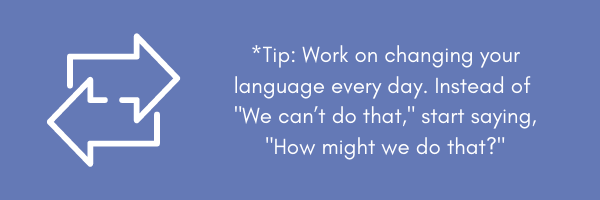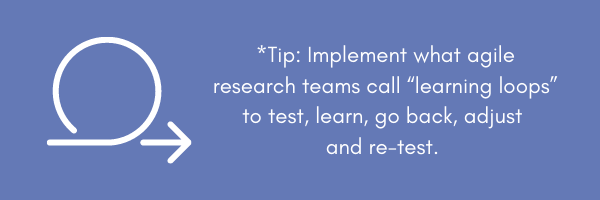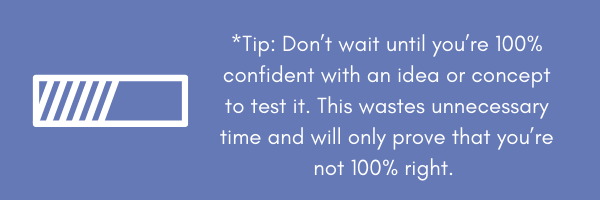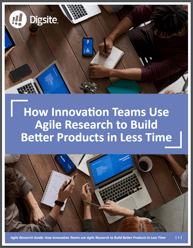Operating in an uncertain world requires the ability to think like a startup. This year, we're encouraging companies to go back to their entrepreneurial roots. Back when decisions were made by relying on bold and courageous thinking. Agile research helps insights teams navigate those uncertainties with quick thinking and speedy decision-making.
We have the belief that when you kick off with the right mindset, agile research can work even harder for you. If your team is in need of a behavior reset to get on a more agile path, start here.
This path starts with six foundational behaviors that we believe are necessary to operate with more agility.
1. Check your “we can't do that” at the door.
When you think that something can’t, won’t or shouldn’t work, step back and throw that notion far, far away. You can’t confirm if an idea or concept will ring true unless you give it a go. Don’t be afraid to test, take that feedback and start again.

2. Squeeze the juice out of your resources.
By looking at the resources you and your team have at hand, you’ll feel less stuck than you think you are. Whether it's money, time or people, we all have so much at our fingertips. Assess these three primary resources with your team:
-
- Strength: Everyone brings unique knowledge to the table.
- Network: We all have a friend of a friend who can answer a question.
- Assets: Take a second look at your physical assets, products, plans, colleagues and systems.
While taking inventory of your team’s toolkit, it’s also helpful to know how you stack up against competitors. Digsite created this self-assessment tool where you’re given a score based on seven areas of agility.
3. Embrace a growth mindset.
A fixed mindset would say:
-
- We have to know all the answers.
- My skills are fixed.
- My value is based on my ability to do well against those skills.
- I need to avoid this because it’s going to show what I lack.
But a growth mindset would flip this into:
- My skills are malleable and there's always room for improvement.
- My value is placed on working hard and continuing to learn and grow
- I might not be good at this right now, but it's something that I can continue to build on.
- If something does go wrong, I’m embracing the fact that I have the opportunity to fine tune this idea.
Keep in mind that you can have both from day to day. The beauty of a growth mindset is that you can take your fixed mindset behaviors and work on embracing those challenges.
4. Embrace the unexpected.
Getting from point A to point B is rarely a straight line. Despite our best intentions to create smooth timelines, most of the time it looks like a drive through the Rocky Mountains. However, our teams can learn to better pivot to continually embrace change.

Remind your team and your clients that even the most carefully-crafted plans can go off the rails. Embrace the unexpected and see what magic can happen after going through a learning loop. Focus on your end goal, and lean into the lane changes, U-turns, detours and speed bumps.
5. Operate with urgency.
Moving with urgency doesn't equate to moving fast. Urgency is achieved by keeping up with daily, weekly and monthly milestones. Having milestones in place gives your team the drive and discipline to make regular progress. Perseverance is key for agile research teams to use learnings from every milestone (and speed bump) to fine-tune ideas.
6. Operate like a founder.
Remember that even the most experienced agile research teams don’t have all the answers. It takes courage to admit that you’re unsure and learn from it. Great leaders start at point A facing the unknown, but when you approach agile research with the right mindset, the process is much clearer.

Agile research teams often seek out best practices and guides to supplement their work by partnering with research providers. Research partners can provide the right structure for strategic problem solving. Finding a research partner that’s like-minded and encourages agility is crucial.
In summary, a great agile research leader should empower their team to:
-
- Change their language from “We can’t do that,” to “How might we do that?”
- Squeeze out every possible resource they have at hand.
- Turn a fixed mindset into a growth mindset.
- Embrace learning loops by testing, learning, going back, adjusting and re-testing.
- Drive milestones to make regular progress.
Facing the unknown means that your team will encounter setbacks, but feel confident that you’re doing the necessary work and embracing the right mindsets. Think about what you and your team can do tomorrow to make progress. And remember that if you’re testing frequently and learning quickly, you’re doing it right.

To learn more about how some of today’s leading organizations are using agile research
to delight their customers and drive competitive advantage, check out our eBook: How Innovation Teams use Agile Research to Build Better Products in Less Time.




